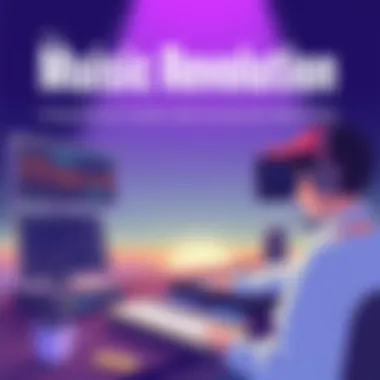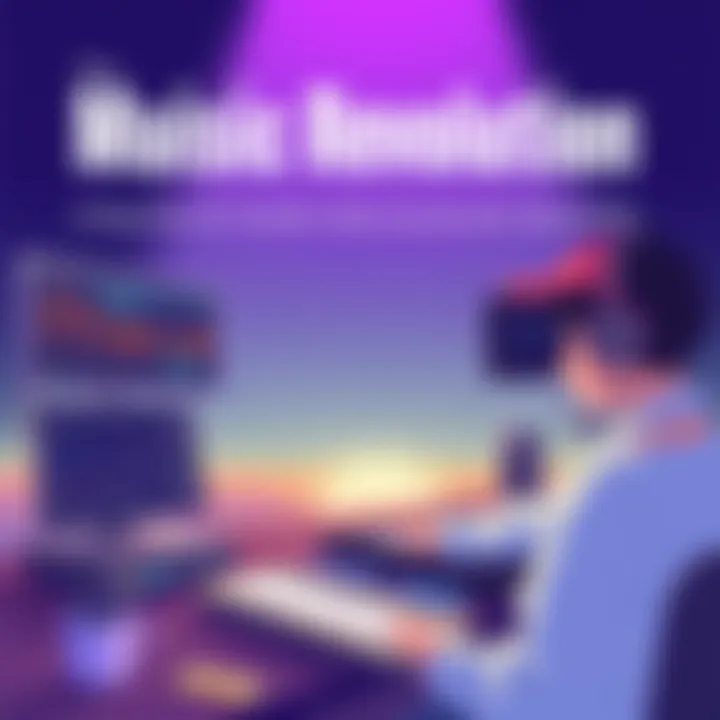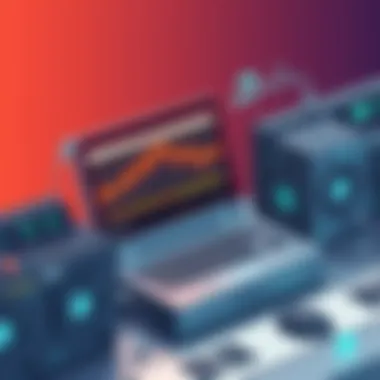The Music Revolution: Transformative Sounds and Shifts


Intro
Music has always been a force that resonates deeply within society, echoing the values, dreams, and struggles of its time. In this exploration, we will peel back the layers of the music revolution that has shaped our cultural landscape. From the stirring rhythms of the blues that arose from the plantations of the American South to the vibrant beats of hip-hop that echo through urban environments today, music serves as both a mirror and a mold for societal transformation.
We find ourselves standing at the crossroads of innovation, experiencing a seismic shift in how music is produced, consumed, and understood. As technology continues to warp the rules of art and expression, we must ask ourselves: how has the evolution of sound influenced the cultural movements of our time? In this article, we will delve into the interplay between technological advancements and sociopolitical currents, revealing how each informs the other in a dance of creativity.
As we embark on this journey, we will dissect key genres, spotlight notable artists, and elevate discussions about their cultural significance. Through this lens, it becomes clear that music is more than mere entertainment; it is a vital part of our collective conscience, a commentary on our experiences and aspirations. This analysis aims to paint a comprehensive portrait of the transformative power of music and the undeniable role it plays in the shaping of our society.
Foreword to the Music Revolution
The topic of the music revolution is not just about melodies and rhythms; it encompasses a rich tapestry of cultural shifts and technological advancements that have shaped societies around the world. From the jazz clubs of New Orleans to the digital streams of today, music acts as both a mirror and a catalyst for change, reflecting the issues and aspirations of the times. This article sheds light on the significance of understanding the music revolution, examining its transformative effects on society, technology, and culture.
Benefits of Exploring the Music Revolution
A deep dive into this subject offers readers valuable insights into how music influences and molds collective identities. For instance, genres like rock 'n' roll and hip hop haven’t merely entertained; they've sparked revolutions, challenged norms, and given a voice to the marginalized. Understanding these dynamics helps us appreciate not just the art itself, but the socio-political context behind it, widening our perspective of human expression.
Considerations about the Music Revolution
When we consider the music revolution, it's crucial to acknowledge the historical contexts that have led to significant waves of change. Each era's innovation—be it the advent of vinyl records, the influence of radio, or the explosion of digital platforms—has played a pivotal role in how music is created, shared, and consumed. This evolution prompts us to question not just what music is, but what it means to us as individuals and as members of various communities.
Defining the Music Revolution
To define the music revolution, one must consider how it embodies numerous shifts in sound, style, and societal impact over decades. It goes beyond mere changes in musical styles; rather, it signifies profound alterations in how music creates social solidarity and how it functions as a vehicle for artistic freedom.
- Multifaceted Changes:
The music revolution encapsulates varied phases, including the rise of distinct genres, the incorporation of technology in production, and the emergence of new distribution channels. - Societal Reflection:
Music not only reflects societal changes but also acts as a catalyst for movements. For instance, protest music from the 1960s voiced discontent against war and inequality, while today’s streaming platforms allow a broader range of voices to be heard.
Historical Context
Understanding the historical context of the music revolution is crucial—it grounds our exploration in reality and elucidates how music has navigated through tumultuous times. The journey of music is interwoven with significant events, such as the civil rights movement and technological innovations.
- Pre-20th Century Foundations:
Music has always been an intertwining thread in human history. From folk traditions to classical compositions, the foundations laid in these earlier times paved the way for popular music. - 20th Century Turbulence:
The world witnessed drastic changes during the 20th century, including two World Wars and social upheaval. Genres like jazz emerged amidst prohibition, and rock 'n' roll flourished in the wake of post-war societal shifts. - Contemporary Era:
Fast forward to the digital age, where the internet revolutionized how music is accessed and shared. This era faces its own challenges and opportunities, reshaping not only the music industry but also listener habits globally.
"Music is the shorthand of emotion." – Leo Tolstoy
In summarizing the introduction to the music revolution, we see that music is not merely for entertainment but serves a profound role in reflecting and even driving societal changes throughout history. Recognizing this allows us to appreciate the art form more deeply—acknowledging its power, its context, and its potential for future transformation.
Key Historical Phases of Musical Change
Music has long been interwoven with the fabric of society, acting as both a mirror and a hammer, reflecting cultural realities while also reshaping them. Understanding the key historical phases of musical change is vital for dissecting how the present soundscape has been crafted. Each phase marks significant shifts that demand attention, not only for their cultural significance but also for their technological implications. The evolution showcases how music adapts to, and sometimes influences, societal changes.
The Birth of Popular Music
The birth of popular music began in the late 19th century. With the emergence of ragtime and blues in the United States, we saw a pivotal transition from folk traditions to a more commercial, widespread consumption of music. Popular music redefined access and participation. This era made music accessible to the masses, moving away from the elite confines of concert halls and operas.
- Key Elements:
- Ragtime brought syncopation and rhythm to the forefront, captivating audiences.
- Blues provided a voice for the marginalized, bringing emotional storytelling to the mainstream.
Virtuous artists like Scott Joplin and Bessie Smith began to gain recognition, paving the way for future stars. The technology of the phonograph played an important role, as it allowed music to be captured and widely circulated for the first time. Suddenly, a melody could echo through homes, allowing society to share experiences despite distance.
The Rise of Counterculture
The 1960s was a transformative decade for music, encapsulating the rise of counterculture. Artists began to express dissent and challenge the status quo through song. Rock and folk music became the anthems for movements. Iconic figures such as Bob Dylan and Joan Baez raised their voices, guiding the youth through turbulent times marked by civil rights struggles and anti-war sentiments.
Key Considerations:
- Protest songs were not just art; they acted as vehicles for change, shaping public opinion and mobilizing action.
- Festivals like Woodstock created a physical space for unity and collective experience.
The synergy between music and the counterculture underscored the potency of sound in rallying communities around shared beliefs. Music became more than mere entertainment; it morphed into a battleground for ideas, shaping identities and relationships across generations.
Digital Transition in Music
As we entered the 21st century, the digital transition reshaped every aspect of music. The advent of the internet introduced new models for production, distribution, and consumption. No longer tied to physical media, music was free to flow and evolve unlike anything that had come before.
- Important Advances:
- MP3 technology revolutionized how music was created and shared, leading to the widespread availability of songs at the click of a button.
- Platforms like MySpace and later Spotify changed how artists interact with their audience and how fans discover new sounds.


This digital transformation allowed for a democratization of musical expression, where indie artists could bypass traditional gatekeepers, reaching audiences globally. In this environment, the listener became a participant, curating their own playlists and often leading to a more personalized musical experience. This evolution prompts questions about the sustainability of artistic integrity in an increasingly commercialized space, a tension that continues to echo through the industry.
"Music can change the world because it can change people." – Bono
As we reflect on the key historical phases of musical change, it’s clear that music not only evolves but also reshapes society in intricate ways. Each phase reinforces the idea that music is not a mere compilation of sounds, but a profound statement of identity, culture, and progress.
Technological Innovations and Their Impact
The landscape of music has been irrevocably altered by technological innovations. Waves of change have surged through recording, distribution, and consumption of music. These advancements don’t just enhance efficiency; they also reshape how artists create and connect with their audience. Understanding the implications of these innovations is crucial, as they offer insights into the future direction of music as a cultural beacon.
Recording Technologies
Recording technologies are the backbone of modern music production. The transition from analog to digital recording fundamentally shifted how sounds are captured and manipulated. Early techniques involved cumbersome tape machines and manual mixing, which limited musicians' creative possibilities. Fast forward to today, musicians wield powerful software like Pro Tools and Ableton Live, turning their home studios into professional-grade production environments.
These digital tools enable intricate layering of sounds, precise editing, and the ability to experiment without the hefty costs associated with traditional recording. Furthermore, artists can harness tools like Auto-Tune, which enhances vocal performances or alters pitches. This technology has democratized access to creating high-quality music, allowing independent artists to flourish without the need for major label backing.
The Internet and Music Distribution
The rise of the Internet transformed the way music is shared and distributed. Before, a limited number of labels and distributors held the reins over what could be heard and by whom. Now, with platforms like Bandcamp, SoundCloud, and ReverbNation, artists can share their work directly with fans, bypassing traditional gatekeepers altogether. This shift not only levels the playing field but also fosters a sense of community among music lovers, forming niche markets where unique sounds can thrive.
Consider how the shift from CDs to digital downloads paved the path for independent artists. Today, musicians can release an album and have it available worldwide within days. The immediacy of the Internet has not only accelerated this process but also impacted how artists promote themselves through social media. Being active on platforms like Instagram or TikTok allows creators to build a direct relationship with their audience, crafting loyal followings while staying relevant in an ever-evolving market.
Emergence of Streaming Services
The advent of streaming services is arguably the most significant revolution in music consumption. Platforms like Spotify, Apple Music, and YouTube have changed the game entirely, providing instant access to a vast library of music for a monthly fee or sometimes for free. This model has altered listeners’ behaviors, leading to a shift from ownership to access.
"With great access comes great responsibility; the listening habits of today reflect not just the music itself, but the platform that delivers it."
The artists receive royalties through complex algorithms, depending on stream counts, which often raise questions about fairness and sustainability. As such, discussions surrounding compensation for artists and the future of the music industry are lively and contentious. The convenience of a single subscription for endless music has reshaped marketing strategies, with artists needing to adapt promotional tactics to highlight new releases in an ocean of content. Accessibility paired with analysis is a double-edged sword that brings both opportunity and challenge.
In essence, technological innovations have not just modified how music is experienced; they’ve done so in a manner that intertwines deeper cultural narratives, social connections, and economic considerations within the industry. As we continue exploring these layers, the significance of innovation remains at the forefront of the ongoing music revolution.
Genres That Shaped the Revolution
The influence of music genres on societal change cannot be overstated. Each genre is not merely a collection of sounds, but a profound articulation of cultural identity and aspirations. This section sheds light on three pivotal genres—Rock and Roll, Hip Hop, and Electronic Music—that shaped the music revolution and, by extension, the cultural landscape of their times.
The Impact of Rock and Roll
Rock and Roll emerged in the mid-20th century, a musical form that was like tossing a match onto dry grass, igniting a full-blown cultural inferno. A concoction of rhythm and blues, country, and gospel, it captured the exuberance and restlessness of a generation eager to break away from the norms and restrictions of the past.
The genre paved new paths for cultural expression, from the rebellious lyrics of Chuck Berry to the hypnotic guitar riffs of Elvis Presley. Rock and Roll became synonymous with the fight for civil rights, as artists like Sam Cooke used their music to push against systemic inequalities. The impact was palpable:
- Social Change: Rock and Roll didn't just entertain; it mobilized movements. Songs crafted during the 60s and 70s often discussed social issues, making the genre a powerful tool for change.
- Youth Culture: It created a distinct culture around youth, where fashion, language, and social behaviors shifted dramatically.
- Global Influence: The genre quickly spread across continents, influencing artists worldwide and infusing local sounds with rock elements.
In this way, Rock and Roll became a cultural tapestry, entwining itself with significant historical moments.
The Evolution of Hip Hop
Hip Hop, born in the Bronx in the late 1970s, burgeoned from a mix of street culture, lyricism, and rhythmic innovation. It was a fresh voice for marginalized communities, using beats and bars to narrate the struggles of life in urban America. The genre's evolution over time illuminates not only musical change but also the shifting dynamics of society itself.
Key facets of Hip Hop include:
- Lyricism as Narrative: Rappers like Kendrick Lamar have turned personal stories into political statements, deepening the genre's roots in activism.
- Cultural Expression: From graffiti art to breakdancing, Hip Hop encompasses diverse forms of artistic expression, embodying the spirit of innovation.
- Social Commentary: Hip Hop artists frequently discuss pressing societal issues—police brutality, systemic racism, and economic inequality—making it a poignant vehicle for awareness.
The genre's adaptability has allowed it to thrive, influencing various aspects of culture across the globe, proving that the heart of Hip Hop beats firmly in social commentary and community narratives.
The Influence of Electronic Music
Electronic music, with its technological roots and multifaceted soundscapes, has ushered in a revolution of rhythm and pulse. Emerging from underground clubs and raves, the genre has blurred lines between traditional music structures and the limitless possibilities offered by modern technology.
- Innovative Sound: Artists like Daft Punk and Skrillex have transformed the sonic landscape by marrying intricate electronic production with catchy hooks, creating genres like house, techno, and dubstep.
- Global Reach: Electronic music crossed borders without much resistance, finding acceptance in diverse cultures and communities, becoming a universal language, connecting enthusiasts around the world.
- Cultural Movements: Festivals like Burning Man and Tomorrowland demonstrate how electronic music fosters communal experiences and cultural phenomena, drawing fans into a shared ecstasy.
In many ways, electronic music revolutionizes not just how we hear sound but also how we engage with one another through music.
Each genre discussed highlights a unique thread in the rich tapestry of musical evolution, underscoring how genres often act as the heartbeat of cultural and societal shifts.


Cultural Movements Driven by Music
Music acts not merely as an art form but as a powerful instrument of social change. Within the realm of cultural movements, it plays an integral role that deserves attention. By examining how music drives cultural shifts, one can appreciate its potential to unite diverse groups and amplify diverse voices.
Protest Music Through the Ages
From folk to punk rock, protest music has consistently emerged during times of strife. It echoes the sentiments of those who feel marginalized or silenced. An example is Bob Dylan's "The Times They Are a-Changin'" which became an anthem during the civil rights movement of the 1960s. Similarly, the revolutionary spirit during the Vietnam War was encapsulated through songs like Creedence Clearwater Revival's "Fortunate Son."
Music can articulate frustrations and offer hope. In South Africa, during the Apartheid era, artists like Hugh Masekela used jazz to critique the regime's injustices, uniting people under a common cause.
"Music is a weapon of the future." - Fela Kuti
Most importantly, protest songs have the ability to evolve over time. Modern musicians like Childish Gambino with "This Is America" continue this tradition, engaging younger audiences in social commentary about police brutality and systemic racism. As such, protest music remains an essential means of expression, allowing individuals to voice concerns and challenge the status quo.
Music as a Unifying Force
Music transcends boundaries, bringing together individuals from varied backgrounds. Festivals like Coachella or Glastonbury are not just about enjoying tunes; they foster a spirit of community. Attendees often reference a shared experience that creates lasting connections.
Consider the song "One Love" by Bob Marley. Its message of peace serves as a rallying cry across generations, and even geographical borders. Music bridges cultural gaps and nurtures relationships across racial and social divides.
This unifying force is most evident during global events like Live Aid, where artists from different cultures came together for a common purpose—raising awareness about famine in Africa. This type of collaboration illustrates how music can emphasize our shared humanity and catalyze collective action.
Influence on Identity and Community
Through music, individuals often find ways to express their identity. Genres like hip-hop, reggae, and folk resonate deeply with their respective communities, often reflecting their challenges and victories. For instance, hip-hop originated from the struggles of marginalized communities in the Bronx, New York, providing a voice for those often unheard.
Moreover, music has the ability to shape communal identity. In some indigenous tribes, drumming and singing during ceremonies foster a sense of belonging, reinforcing cultural history and values. These participatory elements within music allow people to connect on a personal level, enhancing their sense of community.
Identity can also manifest through the artists themselves. Musicians like Beyoncé, who celebrate Black culture, influence many by promoting expressions of pride and resilience. As she says, "We need to reshape our own perception of how we view ourselves."
By examining how music intertwines with various cultural movements, one unravels the profound ways it influences society, strengthens communities, and fosters understanding. This relationship is not just an academic consideration; it impacts how generations move forward together.
Noteworthy Artists and Their Contributions
When we talk about music, it’s impossible to ignore the especially significant role that outstanding artists and their unique contributions play in the shaping and evolution of the musical landscape. This section dives into the lives and works of artists who have not just created sounds but have, in many ways, sculpted cultural norms, driven social change, and enriched communities through their art. They serve as the heartbeat of the music revolution, illustrating how individual creativity can resonate on a global scale.
Trailblazers of the 20th Century
The 20th century was a crucible of creativity, where the air was thick with revolutionary sounds that continually reshaped society. Icons like Louis Armstrong, Billie Holiday, and Bob Dylan pushed the boundaries of what music could express. Armstrong's innovative trumpet playing and unique vocal style not only popularized jazz but also dismantled racial barriers in a deeply segregated America. Holiday's poignant ballads captured the soul of the human experience, turning personal pain into universal expression. Meanwhile, Dylan’s folk anthems not only redefined lyrical depth but also became rallying cries for civil rights, influencing generations to seek social justice.
Their contributions were not mere performances; they were statements that reverberated long after the last note faded. Artists like these paved the way for future musicians, showcasing the possibilities that lie in pushing artistic boundaries. Their influence reminds us that the true power of music lies in its ability to reflect and affect social dynamics.
Modern Icons of Music
As we look at contemporary artists like Beyoncé, Kendrick Lamar, and Lady Gaga, we witness the continuation of this legacy but with a twist that speaks to today’s digital age. Beyoncé, with her blend of power and vulnerability, has harnessed the potential of social media, using her platform to shine a light on issues from feminism to racial inequality. Similar can be said for Kendrick Lamar, whose storytelling and lyrical prowess tackle systemic issues in a way that resonates profoundly with audiences. On the other hand, Lady Gaga's ability to blend genres and challenge norms has made her an emblem of self-expression in a society predisposed to judgement.
These modern icons embody a blend of artistry and activism, deepening the conversation around important social issues while engaging with their audiences on multiple levels. With the aid of technology, they reach fans globally in ways that were unimaginable not long ago, solidifying their roles in the music revolution.
The Role of Independent Artists
In the backdrop of major labels and commercial success lies another realm of music paved by independent artists. Artists like Chance the Rapper and Tash Sultana demonstrate how to chart a course from the underground to mainstream visibility without the shackles of traditional record labels. Their narratives highlight a vital shift in the industry’s landscape, where creative freedom often trumps commercial viability.
These independent trailblazers illustrate how technology has dismantled barriers that used to be insurmountable for aspiring musicians. Digital platforms like Bandcamp and SoundCloud empower artists to distribute their music directly to consumers, enabling authenticity and personal connection.
The essence of these artists speaks volumes; they embrace the DIY ethic, showcasing the broadening spectrum of musical expression entirely detached from corporate influence. This resurgence of independent artistry not only enriches the overall music ecosystem but also challenges the status quo, inviting audiences to recognize diverse voices within the industry.
"Music is the universal language of mankind." - Henry Wadsworth Longfellow
Through examining the stories of these noteworthy artists, it becomes clear: the tapestry of the music revolution is woven from threads of innovation, individuality, and resilience. Each artist contributes a stitch, making the whole picture a vibrant reflection of humanity's collective journey through sound.
Global Influences on Music
The landscape of music is a canvas painted with diverse cultural strokes from around the world. When we talk about global influences on music, we’re diving into a phenomenon where different traditions, styles, and practices merge to create something unique. This section unpacks the rich tapestry formed by these interactions, shedding light on how they shape current musical trends, genre evolution, and artist collaborations. Understanding this facet is crucial, as it not only highlights the interconnectedness of global music but also emphasizes the ways in which cultural exchange fosters innovation in sound.
Cross-Cultural Collaborations


Cross-cultural collaborations in music have become a potent vehicle for change and creativity. When artists from different backgrounds join forces, the result can be something astonishing, transcending the traditional borders set by language or geography. For instance, the partnership between Carlos Santana and Mahavishnu Orchestra's John McLaughlin brought together rock, jazz, and Indian classical influences. This collaboration went beyond mere genre blending; it fostered an appreciation for diverse musical forms, inviting audiences to experience something novel.
Moreover, this blending isn't just for show. It often involves deep engagement with each others’ cultural nuances. Consider the album "A Nepali Heart" produced by the collaboration between American folk musician J. S. Ondara and Nepali artists. Each song captures a slice of life on both sides, marrying folk elements from both cultures.
The importance of these cross-cultural endeavors cannot be overstated. They not only promote understanding but can also serve as a platform for addressing social issues. As artists draw attention to underrepresented voices, music becomes a medium for change.
In many cases, the enriching experience of these collaborations highlights the notion that great music knows no bounds. It has the ability to weave stories that resonate on multiple levels.
The Role of Festivals and Live Performances
Festivals across the globe act as melting pots for diverse musical experiences. They gather artists from various backgrounds, creating an immersive environment where listeners can absorb different sounds in one place. The Global Citizen Festival, for example, invites musicians from different countries to advocate for social issues while showcasing their cultures through music.
Live performances amplify the emotional weight of music. They transform a static song into a shared experience of joy, sadness, and everything in between. Imagine attending a concert where African drumming intertwines with American blues; the energy is electric and infectious. Audiences don't just listen; they participate, they dance, and they connect.
More than just entertainment, these gatherings play a critical role in cultural preservation and innovation. Artists inspired by their surroundings often leave a mark on the music they create. This impact can ripple through various music scenes, influencing local artists and introducing new aesthetics into their work.
The Future of Music in a Changing Landscape
The future of music is painted with broad strokes of innovation and adaptability. As the industry evolves, the integration of technology plays a monumental role in shaping how music is created, consumed, and monetized. Understanding these changes is crucial, not just for artists and producers, but also for audiences who crave new experiences and connections through sound. Reflecting on these shifts allows for a deeper appreciation of music in our lives, especially as we stand on the precipice of unprecedented change.
Artificial Intelligence in Music Creation
Artificial intelligence, or AI, is emerging as a powerful tool in the creative realm of music. From composing original scores to enhancing sound quality, AI technologies are setting the stage for new possibilities. For instance, platforms like OpenAI’s MuseNet enable users to create music across various genres, blending styles seamlessly. This collaboration between human creativity and machine learning raises compelling questions about authorship, originality, and the essence of music itself.
- Benefits of AI in Music Creation:
- Efficiency: AI tools can quickly analyze vast libraries of music, helping to create new compositions in minutes instead of hours.
- Accessibility: These technologies can empower amateur musicians to experiment with music creation, often without requiring extensive technical knowledge.
- Diversity of Sound: AI algorithms can incorporate a blend of cultural influences that may otherwise remain unexplored, offering listeners unique auditory experiences.
Nonetheless, the rise of AI in music creation isn't without hesitations. For many, the thought of a machine producing melodies might feel somewhat robotic or devoid of the emotional depth that human artists bring to their work. This paradox invites discussions about what it really means to be a musician in a digital age.
The Continuing Evolution of Genres
Genres play an essential role in categorizing and contextualizing music. Yet, as technology and cultural exchanges become more fluid, the boundaries between genres are increasingly blurred. Today, this format shifts rapidly, giving birth to hybrid styles that defy traditional classifications. Consider the synergy between rap and country, as seen in the success of artists like Lil Nas X's "Old Town Road," which redefined genre definitions and audience expectations.
- Noteworthy Trends:
- Cross-Genre Collaborations: Artists from wildly different backgrounds collaborate, producing fresh sounds that resonate with broader audiences.
- Global Influences: Access to international music through platforms like Spotify exposes listeners to a diverse array of styles, leading to an intermingling of genres and cultural practices.
- DIY Culture: Aspiring artists leverage social media and production tools to explore unconventional styles outside traditional industry gatekeeping.
Artists not only adapt but play a vital role in shaping the ongoing changes within genres, and their willingness to take risks paves the way for future sounds.
Sustaining Artistic Integrity in a Commercial World
As commercial interests in the music industry continue to surge, the balance between creativity and profitability becomes increasingly delicate. Independent artists often feel the pressure to conform to market trends to achieve success, which can compromise their artistic vision. However, platforms like Bandcamp and Patreon offer new avenues for musicians to monetize their work while maintaining authentic connections with their audience.
- Considerations for Artists:
- Authenticity vs. Commercialism: Maintaining a genuine expression in one’s music while navigating the demands of commercial viability can be challenging.
- Building Community: Engaging directly with fans through social media and live performances fosters loyalty and support that transcends mere transactional relationships.
- Presence of Gatekeepers: Labels and streaming platforms still hold considerable influence, and challenging their norms can be a double-edged sword for artists seeking independence.
"Music is an outburst of the soul." — Frederick Delius
For further reading, you can visit:
- Wikipedia on Artificial Intelligence in Music
- Britannica on Music Genres
- Reddit communities for Music Discussion
- The Future of Music
- Musician's Guide to Success
Ending: The Enduring Legacy of the Music Revolution
The music revolution has carved an indelible mark on society, resonating well beyond the notes that fill our speakers. It plays a pivotal role in understanding contemporary culture and the myriad ways in which sound influences our lives. As we reflect on this journey through history, technology, and cultural shifts, it's essential to highlight the specific elements that contribute to its lasting significance.
A transformative legacy is often rooted in various factors:
- Cultural Identity: Music has served as a canvas for expressing cultural identities. Genres like reggae stem from the socio-political climates of their origins, echoing the struggles and triumphs of communities. This historical context enriches our understanding of identity today and shows how music can unify or divide based on cultural narratives.
- Social Movements: Music is not just entertainment; it is often a clarion call for change. From the anthems of the Civil Rights Movement to the protest songs emerging today in response to global issues, music acts as a vehicle for collective sentiment and activism. These songs reflect the zeitgeist and serve to mobilize people toward a common cause.
- Technological Influence: The rise of digital platforms has democratized music production and distribution, allowing artists from all backgrounds to share their voices. This access not only promotes diversity in music but challenges the long-held paradigms of the music industry. As we see technology evolve, so too does the way we create and consume music, ensuring that innovation continues to breathe new life into the artistic landscape.
"Music is an outburst of the soul." – Frederick Delius
This quote encapsulates the essence of music's role in humanity. The emotional connections forged through song and lyrics drive home the sentiment that music is deeply rooted in our experiences.
Moreover, the ongoing evolution of genres signifies that the music revolution is far from concluded. With genres constantly merging, new sounds emerge that reflect contemporary society's complexity. Genres like trap, which marries hip-hop with electronic elements, represent a shift in musical tastes and cultural dialogues among youth.
Consider the role of independent artists today; platforms like Bandcamp and SoundCloud have created avenues for niche genres to flourish. These artists challenge the mainstream, and in doing so, help preserve artistic integrity against the backdrop of commercial pressures.
In summary, as we observe the unfolding chapters in the story of music, we recognize its power to shape societal norms, influence culture, and articulate political sentiments. The legacy of the music revolution is a testament to humanity's resilience and creativity. This rich history and ongoing evolution will continue to inspire future generations, keeping the spirit of revolution alive as sounds transform and new cultural landscapes emerge.
For a deeper exploration of music's historical journey, consider visiting resources like Wikipedia and Britannica, where expansive articles delve into the transformative power of music across time. Whether through festival culture, historical movements, or individual narratives, the stories told through music will always be an essential component of our shared experience.







